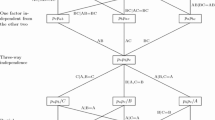Abstract
Given a frequency table \({F=\{f_{jk},(j,k)\in\,J\times K\}}\) crossing two categorical variables J and K, we consider a family of metrics of L p -type on J defined by \({d_J^p (j,j^{\prime}) = \Sigma_k g(f_{.k})|f_{jk}/f_{j.} - f_{j^{\prime}k}/f_{j^{\prime}.}|^p}\), where g is a positive function, and a symmetrical one on K. We investigate under which conditions on g, the famous principle of distributional equivalence is fulfilled by these metrics for every rational or every real F.
Similar content being viewed by others
References
Benayade M, Fichet B (1994) Algorithms for a geometrical P.C.A. withthe L 1-norm. In: Diday E et al (eds) Studies in classification, data analysis, and knowledge organization. New approaches in classification and data analysis. Springer, Berlin, pp 75–84
Benzécri JP (1973) L’analyse des données 2. L’analyse des correspondances. Dunod, Paris
Benzécri JP (1982) Histoire et préhistoire de L’Analyse des Données. Dunod, Paris
Carroll JD, Arabie P (1998) Multidimensional scaling. In: Birnbaum M (eds) Measurement, judgment and decision making. Handbook of perception and cognition. Academic Press, San Diego, pp 179–250
Choulakian V (2005) Transposition invariant principal component analysis in L 1 for long tail data. Stat Probab Letters 71: 23–31
Choulakian V (2006) Taxicab correspondence analysis. Psychometrika 71: 333–345
Choulakian V (2008) Multiple taxicab correspondence analysis. Adv Data Anal classif 2: 177–206
Domenges D, Volle M (1979) Analyse factorielle sphérique: une exploration. Ann Insee 35: 3–84
Escofier B (1969) L’analyse Factorielle des Correspondances. Publications de l’Institut de Statistique de l’Université de Paris
Escofier B (1978) Analyse factorielle et distances répondant au principe d’équivalence distributionnelle. Revue de Statistique Appliquée 26(4): 29–37
Fichet B (1978) Note sur la métrique de l’analyse des correspondances. Statistique et Analyse des Données 2: 87–93
Fisher RA (1940) The precision of discriminant functions. Ann Eugen Lond 10: 422–429
Greenacre MJ (1984) Theory and applications of correspondence analysis. Academic Press, London
Greenacre MJ, Lewi P (2009) Distributional equivalence and subcompositional coherence in the analysis of compositional data, contingency tables and ratio-scale measurements. J Classif 26(1): 29–54
Guttman L (1941) The quantification of a class of attributes: a theory and method of a scale construction. In: Horst P (eds) The prediction of personal adjustment. Social Science Research Council, New York, pp 251–364
Hayashi C (1952) On the prediction of phenomena from qualitative data and the quantification of qualitative data from the mathematico-statistical point of view. Ann Inst Stat Math 3: 69–98
Heiser W (1989) The city-block model for three-way multidimensional scaling. In: Coppi R, Bolasco S (eds) Multiway data analysis. North-Holland, Amsterdam, pp 395–404
Hirschfeld HD (1935) A connection between correlation and contingency. Proc Camb Phil Soc 31: 520–524
Lauro N, D’Ambra L (1984) L’analyse non symétrique des correspondances. In: Diday E et al (eds) Data analysis and informatics. North-Holland, Amsterdam, pp 433–446
Maung K (1941) Measurement of association in a contingency table with special reference to the pigmentation of hair and eye colours of Scottish school children. Ann Eugen Lond 11: 189–223
Nishisato S (1994) Elements of dual scaling: an introduction to practical data analysis. Lawrence Erlbaum Associates, Hillsdale
Nishisato S (2006) Multidimensional nonlinear descriptive analysis of categorical data. Statistics series. Chapman and Hall, London
Author information
Authors and Affiliations
Corresponding author
Rights and permissions
About this article
Cite this article
Fichet, B. Metrics of L p -type and distributional equivalence principle. Adv Data Anal Classif 3, 305–314 (2009). https://doi.org/10.1007/s11634-009-0049-4
Received:
Revised:
Accepted:
Published:
Issue Date:
DOI: https://doi.org/10.1007/s11634-009-0049-4




